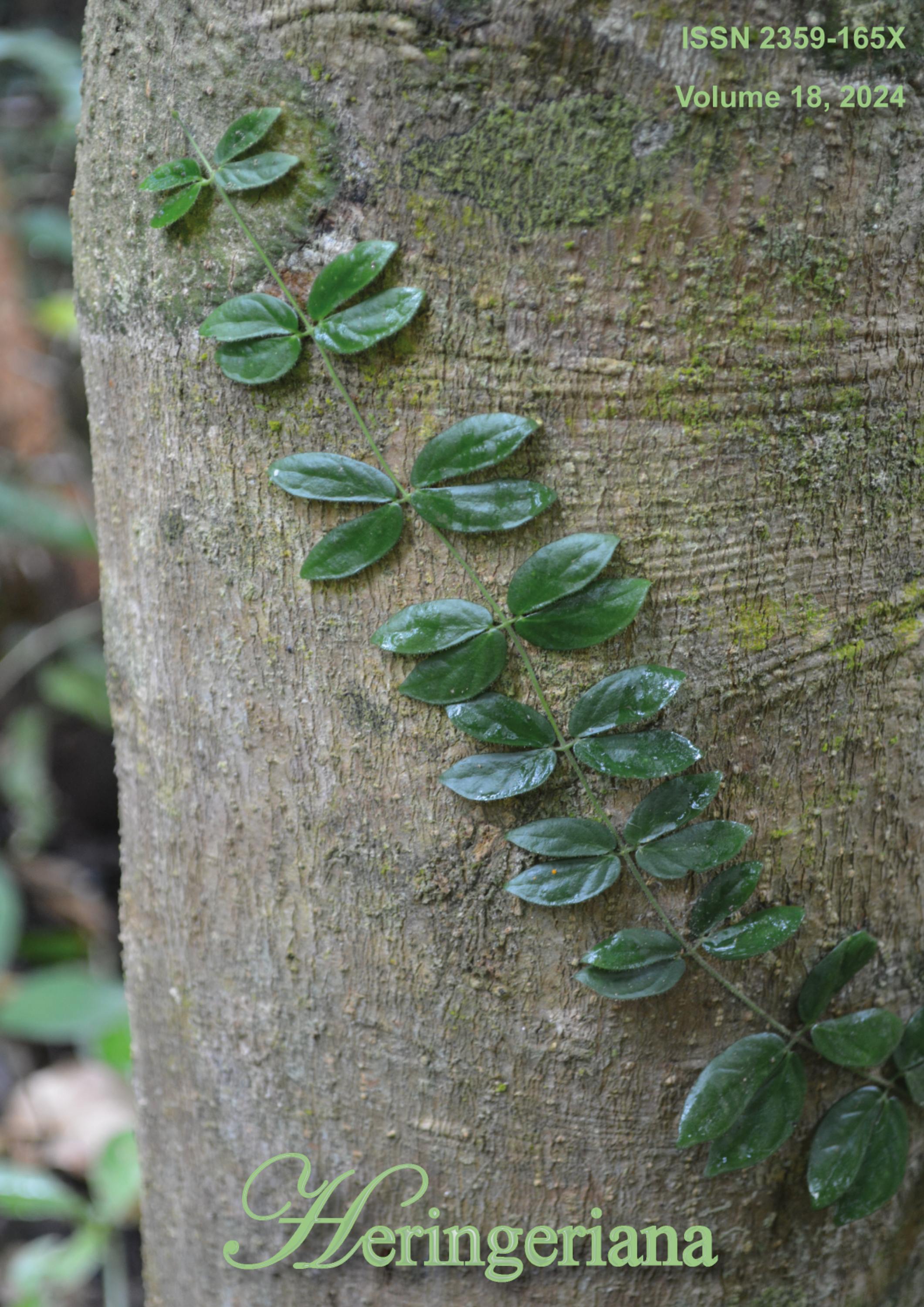Why do spiders use abandoned nests of social wasps (Vespidae)?
DOI:
https://doi.org/10.70782/heringeriana.v18i1.918041Keywords:
Arachnid, Hymenoptera, Nesting, Wasp nestAbstract
The abandoned nests of social wasps (Vespidae: Polistinae) can be utilized by other animals. However, despite commonly found occupying abandoned nests, there are few reports of spiders using these habitats. Thus, this study aims to report the use of abandoned nests of social wasps by spiders in different ecosystems in Minas Gerais, Brazil. The records occurred between November 2022 and March 2023, using an active search methodology, in three locations of the state: Grande Sertão Veredas National Park (Cerrado biome); Federal Institute of Education, Science and Technology of Minas Gerais, Bambuí Campus (transition between Cerrado and Atlantic Forest biomes); and Federal Institute of Education, Science and Technology of Southern Minas Gerais, Inconfidentes Campus (Atlantic Forest biome). A total of 53 social wasps abandoned nests were collected, eight of them with the presence of spiders, that belong to six different species and morphospecies. The use of abandoned social wasps nests may be common for some spider species as their structure and location provide habitats similar to those typically occupied by spiders, along with other benefits. Further studies are needed to explore the frequency of this utilization, given the variability in the feeding habits and environments occupied by spiders.
References
Araujo, D.P. & Maria, M. (2008) Nesting of jumping spiders (Araneae, Salticidae) inside abandoned wasps nests (Hymenoptera, Aculeata). Revista Brasileira de Zoociência 10: 171-173.
Barbosa, R.A.P., Silva, I.K.A. & Oliveira, U.M. (2021) Albuquerque, S. Predação de Drymoluber dichrous (Reptilia: Squamata: Colubridae) por Acanthoscurria sp. (Araneae: Theraphosidae) no Sudoeste da Amazônia Brasileira. Nature and Conservation, v. 14, n. 2, p. 213-218. https://doi.org/10.6008/CBPC2318-2881.2021.002.0019
Bowden, K. & Jackson, R.R. (1988) Social organisation of Scytodes fusca, a communal web-building spitting spider (Araneae, Scytodidae) from Queensland. New Zealand Journal of Zoology 15: 365-368.
Brescovit, A. D. & Rheims, A. (2000) On the synanthropic species of the genus Scytodes Latreille (Araneae, Scytodidae) of Brazil, with synonymies and records of these species in other Neotropical countries. Bulletin-british Arachnological Society 11: 320-330.
Castro, M.M.; Avelar, D.L.G; Souza, A.R. & Prezoto, F. (2014) Nesting substrata, colony success and productivity of the wasp Mischocyttarus cassununga. Revista Brasileira de Entomologia 58: 168-172. http://dx.doi.org/10.1590/S0085-56262014000200009
Chaubey, S.N.R. & Mishra, P.R. (2019) Yadav. "Studies on habit and habitat, external morphology, feeding capacity and prey preference of gray wall jumper spider, Menemerus bivittatus (Dufour)." Journal of Experimental Zoology India 22: 813-816.
Cunha, H.F. & Morais, P.P.A.M. (2010) Relação espécie-área em cupinzeiros de pastagem, Goiânia-GO, Brasil. EntomoBrasilis, 4: 60-63. https://doi.org/10.12741/ebrasilis.v3i3.102
Silva, A.M.A., Dias, V.H.P., Pereira, D.S., Menezes, P.R. & Filgueira, M.A. (2016) Arthropod survey associated with jandaira beehives (Melipona subnitidaDucke) (APIDAE: Meliponinae) at Mossoró-RN, Brazil. ACTA Apicola Brasilica 4: 7 https://doi.org/10.18378/aab.v4i1.4326
Ferreira, E.D.F., Oliveira, T.M.D., Teofilo-Guedes, G.S. & Souza, M.M. (2022) Nidificação de Parachartergus pseudapicalis Willink em substrato vegetal (Hymenoptera, Polistinae). Entomology Beginners 3: 1-3. https://doi.org/10.12741/2675-9276.v3.e030
Höcherl, N., Kennedy, S. & Tautz, J. (2016) Nest thermoregulation of the paper wasp Polistes dominula. Journal of Thermal Biology 60: 171-179. https://doi.org/10.1016/j.jtherbio.2016.07.012
Hozumi, S., Miyano, Y.S., Miyano, S.M. & Zucchi R. (2005) Diel changes of temperature in the nests of two Polybia species, P. paulista and P. occidentalis (Hymenoptera, Vespidae) in the subtropical climate. Journal of Ethology 23: 153-159. http://dx.doi.org/10.1007/s10164-004-0141-3
Jacques, G.C., Ferreira, D.F.W., Moura, A.P., Teofilo-Gudes, G. & Souza M.M. (2022) Nesting of the keyhole wasp Pachodynerus nasidens (Latreille, 1812) (Vespidae, Eumeninae) in a nest of a paper wasp (Vespidae, Polistinae). Journal of Hymenoptera Research 93: 125-130. https://doi.org/10.3897/jhr.93.91298
Jacques, G.C., Barbosa, L.D., Gouvêa, T.P., Simões, N.A., Silva, G.T.G., SIlveira, O.T. & Souza, M.M. (2023) Influence of dry season on social wasp communities (Hymenoptera: Polistinae) in Deciduous Forest. Sociobiology 70: 1-9. https://doi.org/10.13102/sociobiology.v70i2.8361
Jocqué, R. & Alderweireldt, M. (2005) Lycosidae: the grassland spiders. In: Deltshev, C. & Stoev, P. (Eds) European Arachnology. Primeira edição. Acta zoologica bulgarica, Blagoevgrad pp: 125-130.
Lopardo, L. & Martín J.R. (2007) The combing of cribellar silk by the prithine Misionella mendensis, with notes on other filistatid spiders (Araneae: Filistatidae). American Museum Novitates 2007: 1-14. https://doi.org/10.1206/0003-0082(2007)529[1:TCOCSB]2.0.CO;2
Lopes, P.R., Araújo, K.C.S., Lopes, I. M., Rangel, R. P., Santos N.F.F. & Kageyama, P.Y. (2014) Uma análise das consequências da cafeicultura convencional e as opções de modelos sustentáveis de produção–agricultura orgânica e agroflorestal. REDD–Revista Espaço de Diálogo e Desconexão 8: 1-38. https://doi.org/10.32760/1984-1736/REDD/2014.v8i2.6912
Milani, L.R., Jacques, C.G., Clemente, M.A., Coelho, E.L. & Souza, M.M. (2020) Influência de fragmentos florestais sobre a nidificação de vespas sociais (Hymenoptera, Vespidae) em cafeeiro. Revista Brasileira de Zoociências 21: 1-12. http://dx.doi.org/10.34019/2596-3325.2020.v21.29157
Moura, P.A., Jacques, G.C., Guedes, G.T. & Souza, M.M. (2022) A tarantula Lasiodora sp. (Araneae, Theraphosidae) feeding on a groundsnake Atractus pantostictus (Squamata, Dipsadidae). Herpetologia Brasileira, 11: 77-83. https://zenodo.org/doi/10.5281/zenodo.6867833
Morrison, W.R., Bryant, A.N., Poling, B., Quinn, N.F. & Leskey, T.C. (2017) Predation of Halyomorpha halys (Hemiptera: Pentatomidae) from web-building spiders associated with anthropogenic dwellings. Journal of Insect Behavior 30: 70-85. https://link.springer.com/article/10.1007/s10905-017-9599-z
Nentwig, W. (1985) Feeding Ecology of The Tropical Spitting Spider Scytodes Longipes (Araneae,Scytodidae). Oecologia 65: 284–288. http://dx.doi.org/10.1007/BF00379231
NMBE: The World Spider Catalog, American Museum of Natural History, version 24.5. (2023) http://wsc.nmbe.ch
Oliveira, T.C.T., Souza, M.M. & Pires, E.P. (2017) Nesting habits of social wasps (Hymenoptera: Vespidae) in forest fragments associated with anthropic areas in southeastern Brazil. Sociobiology 64: 101-104. https://doi.org/10.13102/sociobiology.v64i1.1073
Pinto, N.P.O. (2005) Estudo do caso: a reutilização de células de ninho abandonado de Polistes (Aphanilopterus) simillius Zikan, 1951 (Hymenoptera: Vespidae, Polistine) por Tetrapedia (Tetrapedia) diversipes Klug, 1810 (Hymenoptera: Apidae, Apinae). Revista de Etologia 7: 67-74.
Redford, K.H. (1984) The termitaria of Cornitermes cumulans (Isoptera, Termitidae) and their role in determining a potential keystone species. Biotropica 16: 112-119. https://doi.org/10.2307/2387842
Ribeiro, J. F. & Walter, B. M. T. (2008) Fitofisionomias do bioma Cerrado. In: Sano, S.M., Almeida, S.P. de (Eds). Cerrado: ecologia e flora. Embrapa. Planaltina, pp. 89-166.
Schmolz, E., Brüders, N., Daum, R. & Lamprecht, I. (2000) Thermoanalytical investigations on paper covers of social wasps. Thermochimica acta, 361: 121-129. http://dx.doi.org/10.1016/S0040-6031(00)00553-0
Santos, G.E., Solera, K., Costa, C.A.D., Marques, M.I., Brescovit, A.D. & Battirola, L.D. (2020) Ground spiders (Arachnida, Araneae) associated with urban forest fragments in southern Amazon. Biota Neotropica 20: 1-13. https://doi.org/10.1590/1676-0611-BN-2020-1062
Šestáková, A.; Černecká, Ľ.; Neumann, J. & Reiser, N. (2014) First record of the exotic spitting spider Scytodes fusca (Araneae, Scytodidae) in Central Europe from Germany and Slovakia. Arachnologische Mitteilungen 47:1-6. https://doi.org/10.5431/aramit4701
Souza, M.M., Guedes, G. T., Milani, L.R., Souza, A.S.B. & Gomes, P.P. (2020) Social Wasps (Vespidae: Polistinae) from the Brazilian Atlantic Forest. Sociobiology 67: 01-12. https://doi.org/10.13102/sociobiology.v67i1.4597
Souza, M.M., Junqueira, A.L., Jacques, G.C., Teófilo-Guedes, G.S. & Zanuncio, J.C. (2022) Camponotus renggeri (Formicidae) predated Agelaia vicina (Vespidae) nest and occupied Parachartergus pseudapicalis (Vespidae) nest. Sociobiology 69: 1-4. https://doi.org/10.13102/sociobiology.v69i2.7883
Somavilla, A., Oliveira, M.L. & Silveira, O.T. Guia de identificação dos ninhos de vespas sociais (Hymenoptera, Vespidae, Polistinae) na Reserva Ducke, Manaus, Amazonas, Brasil. Revista Brasileira de Entomologia 56: 405-414. https://doi.org/10.1590/S0085-56262012000400003
Valenzuela-Rojas, J.C., González-Gómez, J.C., Guevara, G., Franco, L.M., Reinoso-Flórez, G. & García, L.F. (2020) Notes on the feeding habits of a wandering spider, Phoneutria boliviensis (Arachnida: Ctenidae). The Journal of Arachnology 48: 43-48. http://dx.doi.org/10.1636/0161-8202-48.1.43
Vollrath, F. (1982) Colony Foundation in a Social Spider. Zeitschrift Für Tierpsychologie 60: 313–324.
Wenzel, J.W. (1998) A generic key to the nests of hornets, yellowjackets, and paper wasps worldwide (Vespidae: Vespinae, Polistinae). American Museum Novitates 3224: 1–39.
Downloads
Published
How to Cite
Issue
Section
License
Copyright (c) 2024 Maria Luiza Simões Silva, Igor Henrique da Silva, Eike Daniel Fôlha Ferreira, Gabriel de Castro Jacques, Marcos Magalhães de Souza

This work is licensed under a Creative Commons Attribution 4.0 International License.
By submitting, the authors declare that they have not submitted the work to another journal and agree to have their article published under a Creative Commons Attribution 4.0 International BY License (CC BY 4.0), which means that authors retain ownership of the copyright but anyone can use the published content provided the original authors and source are cited. The scientific, orthographic and grammatical content is the full responsibility of the authors.








